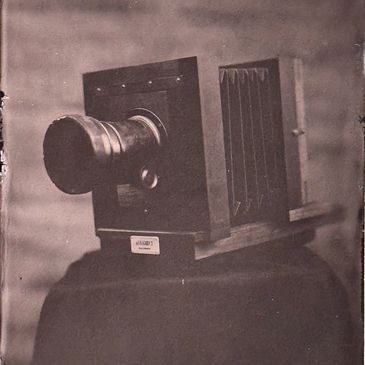WHAT IS A 'TINTYPE?'

Tintype Origins
What Makes a Tintype So Special?
How Is a Tintype Made?
Tintypes began in the 1850's as a more affordable portrait option to its glass-plate cousin, the ambrotype. It was used to document everything from soldiers at war to everyday common portraits, families, and couples in love. Often, a tintypist would travel from town to town in a horse-drawn covered wagon, and the folks in the towns would
Tintypes began in the 1850's as a more affordable portrait option to its glass-plate cousin, the ambrotype. It was used to document everything from soldiers at war to everyday common portraits, families, and couples in love. Often, a tintypist would travel from town to town in a horse-drawn covered wagon, and the folks in the towns would spread the news of his arrival through word of mouth. Many famous photographs were taken this way, including some you have most likely seen, such as the famous portrait of Abraham Lincoln that was used to adorn the United States penny!

How Is a Tintype Made?
What Makes a Tintype So Special?
How Is a Tintype Made?
A tintype is created through several stages. First, a thin metal plate is coated with a light-sensitive substance called "collodion." That collodion-covered plate is then dipped into a bath of silver nitrate for several minutes inside of a portable darkroom, which sensitizes the plate. Then, while still in the dark, the plate is loaded in
A tintype is created through several stages. First, a thin metal plate is coated with a light-sensitive substance called "collodion." That collodion-covered plate is then dipped into a bath of silver nitrate for several minutes inside of a portable darkroom, which sensitizes the plate. Then, while still in the dark, the plate is loaded into a light-proof holder. This holder is then inserted into the camera, the image is taken, and the plate holder is taken back into the portable darkroom, where it is treated with a developing fluid. A very faint image starts to appear while the plate is rinsed in water, and at this point the image on the metal plate is no longer sensitive to light. It's then taken out where fixer is applied, and the image magically appears before your eyes! A little more rinsing, drying, and an expertly laid layer of varnish to protect the tintype is then applied. And THAT, my friend, is the method for which a tintype is created!

What Makes a Tintype So Special?
What Makes a Tintype So Special?
What Makes a Tintype So Special?
One of the coolest part of a tintype is that not only do you get to watch the whole process unfold, but you get to hold it immediately after it's been varnished. It's yours, you can show it to family and friends, give it as a gift, hang it on your wall, mount it in your car...but it's something PHYSICAL. Tangible. HOLD-able. Unlike a digi
One of the coolest part of a tintype is that not only do you get to watch the whole process unfold, but you get to hold it immediately after it's been varnished. It's yours, you can show it to family and friends, give it as a gift, hang it on your wall, mount it in your car...but it's something PHYSICAL. Tangible. HOLD-able. Unlike a digital image that can be erased or files corrupted, your tintype photograph is an actual, physical, tangible THING. And, there's not another one just like it anywhere in the world. Being made from metal, and protected under a veneer of hardened varnish, it is also rugged and sturdy. We still have tintypes from the 1800's that look like they were taken just yesterday! No one knows how long a tintype will last, but we DO know they'll last at least 175 years at this point...and more than likely MUCH longer. So your tintype will be around for MANY generations!
This website uses cookies.
We use cookies to analyze website traffic and optimize your website experience. By accepting our use of cookies, your data will be aggregated with all other user data.